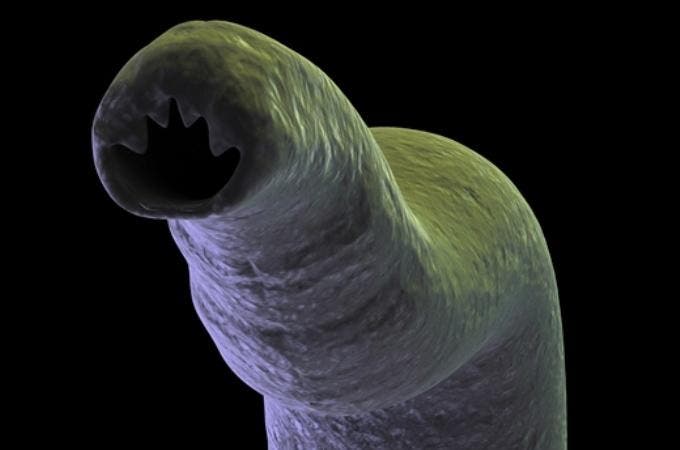Parasitic hookworms infect half a billion people worldwide, causing severe health problems like gastrointestinal issues, cognitive impairment and stunted growth in children. As if the challenges weren’t big enough, the parasites are growing resistant to current drugs. Scientists are trying to tackle this by developing new treatments and vaccines based on the worm’s genome. A team of Caltech sequenced the genome of a hookworm species known as Ancylostoma ceylanicum and found the genes that code key proteins involved in infecting hosts. They hope blocking these proteins from being made might save millions from great sorrow and suffering.

Hookworm is an intestinal parasite most commonly found in tropical and sub-tropical climates of Africa, Asia and Latin America. Hookworm, one of three members of a family of parasites known as the soil-transmitted helminths (STHs), are half-inch long worms that attach themselves to the intestinal wall and feed on human blood. Image: Sabin Vaccine Institute
Most cases of infection happen in developing countries where access to safe drinking water is scarce. Because it’s very difficult to sanitize water sources for millions of people, the best thing we can do at the moment is fight the effects, not the causes. While Ancylostoma ceylanicum isn’t responsible for most infections in humans, the worm was appealing for research because it’s also found in rats. This way, researchers could follow the infection’s progress from start to finish.
Using state-of-the-art DNA sequencing techniques, Caltech researchers sequenced all 313 million nucleotides of the A. ceylanicum genome. Surprisingly, even though the worm’s genome is only 10% the size that of a human, it encodes far more genes – about 30,000 in total, compared to approximately 20,000-23,000 in the human genome. While this may look intimidating, those gene that count in fighting the hookworm are lesser in number.
The team led by Paul Sternberg, the Thomas Hunt Morgan Professor of Biology at Caltech and a Howard Hughes Medical Institute investigator, investigated looked at the RNA involved in infections. RNA is the genetic material that is generated (or transcribed) from the DNA template of active genes and from which proteins are made. They found 900 genes that are turned on only when the worm infects its host—including 90 genes that belong to a never-before-characterized family of proteins called activation-associated secreted protein related genes, or ASPRs.
“If you go back and look at other parasitic worms, you notice that they have these ASPRs as well,” Sternberg says. “So basically we found this new family of proteins that are unique to parasitic worms, and they are related to this early infection process.” Since the worm secretes these ASPR proteins early in the infection, the researchers think that these proteins might block the host’s initial immune response—preventing the host’s blood from clotting and ensuring a free-flowing food source for the blood-sucking parasite.
Developing a drug that blocks these proteins from being generated could avoid infection. The problem is that you might need to block all 90 of them !
“It’s going to take a lot more careful study to understand the functions of these ASPRs so we can target the ones that are key regulatory molecules,” Sternberg said.
Such drugs could prove paramount in fighting hookworm infections, but if scientists know which proteins to target they can make something even better: an anti-A. ceylanicum vaccine. For example, if a person were injected with an ASPR protein vaccine before travelling to an infection-prone region, their immune system might be more prepared to successfully fend off an infection. Findings appeared in Nature Genetics.
“A parasitic infection is a balance between the parasites trying to suppress the immune system and the host trying to attack the parasite,” says Sternberg. “And we hope that by analyzing the genome, we can uncover clues that might help us alter that balance in favor of the host.”









